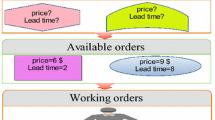Abstract
Speed and price are the two most important factors in customer satisfaction and business success in today’s competitive environment. Time-based product differentiation and segment pricing have provided firms with a great opportunity to profit enhancement. This paper presents a coding system for pricing/queuing models in the literature. In this article, a service/make-to-order firm with heterogeneous price and delivery time-sensitive customers as an M/M/1 queuing system is analyzed. The firm uses customers’ heterogeneity to create market segments. Products offered to each segment differ only in price and delivery time. The objective of this profit-maximizing firm is to determine optimal price, delivery time, and capacity for different market segments. Moreover, solving this problem can help to strategic decision making about supply chain decoupling point. An approach based on uniformization and matrix geometric method so as to calculate the distribution of low-priority customers’ time in system is developed. Then, the proposed pricing/queuing model is implemented by a numerical study and firm’s optimal decisions under shared and dedicated capacity strategies are analyzed and the effect of capacity costs and product substitution is studied. Finally, we have shown how firm’s decisions are influenced by market characteristics, capacity costs, and operational strategies.
Similar content being viewed by others
References
Afeche P (2004) Incentive compatible revenue management in queueing systems: optimal strategic delay and other delaying tactics. Working paper, Northwestern University
Afeche P, Mendelson H (2004) Pricing and priority auctions in queueing systems with a generalized delay cost structure. Manage Sci 50(7):869–882
Allon G, Federgruen A (2005) Competition in service industries. Oper Res 53(1):37–55
Boyaci T, Ray S (2003) Product differentiation and capacity cost interaction in time and price sensitive markets. Manuf Serv Oper Manage 5(1):18–36
Boyaci T, Ray S (2006) The impact of capacity costs on product differentiation in delivery time, delivery reliability, and price. Prod Oper Management POMS 15(2):179–197
Dewan S, Mendelson H (1990) User delay costs and internal pricing for a service facility. Manage Sci 36(12):1502–1517
Dobson G, Stavrulaki E (2007) Simultaneous price, location, and capacity decisions on a line of time-sensitive customers. Nav Res Logistics NRL 54(1):1–10
Ha AY (1998) Incentive-compatible pricing for a service facility with joint production and congestion externalities. Manage Sci 44(12):1623–1636
Ha AY (2001) Optimal pricing that coordinates queues with customer chosen service requirements. Manage Sci 47(7):915–930
Hall JM, Kopalle PK, Pyke DF Static and dynamic pricing of excess capacity in a make-to-order environment. Working paper, Tuck School of Business at Dartmouth
Hill AV, Khosla IS (1992) Models for optimal lead time reduction. Prod Oper Manage 1(2):185–197
Jayaswal S, Jewkes E, Ray S (2011) Product differentiation and operations strategy in a capacitated environment. Eur J Oper Res 210(3):716–728
Katta A, Sethuraman J (2005) Pricing strategies and service differentiation in queues: a profit maximization perspective. Department of Industrial Engineering and Operations Research, Columbia University
Lederer PJ, Li L (1997) Pricing, production, scheduling, and delivery-time competition. Oper Res 45(3):407–420
Li L, Lee YS (1994) Pricing and delivery-time performance in a competitive environment. Manage Sci 40(5):633–646
Mandjes M (2003) Pricing strategies under heterogeneous service requirements. Comput Netw 42(2):231–249
Mendelson H (1985) Pricing computer services: queuing effects. Commun ACM 28(3):312–321. doi:10.1145/3166.3171
Mendelson H, Whang S (1990) Optimal incentive-compatible priority pricing for the M/M/1 queue. Oper Res 38(5):870–883
Neuts MF (1981) Matrix-geometric solutions in stochastic models: an algorithmic approach. Dover Publications, Mineola
Palaka K, Erlebacher S, Kropp DH (1998) Lead-time setting, capacity utilization, and pricing decisions under lead-time dependent demand. IIE Trans 30(2):151–163. doi:10.1023/A:1007414117045
Pangburn MS, Stavrulaki E (2008) Capacity and price setting for dispersed, time-sensitive customer segments. Eur J Oper Res 184(3):1100–1121
Pekgun P, Griffin PM, Keskinocak P (2006) Centralized vs. decentralized competition for price and lead-time sensitive demand. H. Milton Stewart School of Industrial and Systems Engineering, Georgia Institute of Technology, Atlanta (in press)
Pekgun P, Griffin PM, Keskinocak P (2008) Coordination of marketing and production for price and lead time decisions. IIE Trans 40(1):12–30
Ramaswami V, Lucantoni DM (1985) Stationary waiting time distribution in queues with phase type service and in quasi-birth-and-death processes. Stoch Models 1(2):125–136
Ramaswami V, Lucantoni DM (1999) An introduction to matrix analytic methods in stochastic modeling. SIAM, Philadelphia
Rao S, Petersen ER (1998) Optimal pricing of priority services. Oper Res 46(1):46–56
Ray S, Jewkes EM (2004) Customer lead time management when both demand and price are lead time sensitive. Eur J Oper Res 153(3):769–781
Jayaswal S (2009) Product differentiation and operations strategy for price and time sensitive markets. PhD Thesis, University of Waterloo
Sinha SK, Rangaraj N, Hemachandra N (2010) Pricing surplus server capacity for mean waiting time sensitive customers. Eur J Oper Res 205(1):159–171
So KC (2000) Price and time competition for service delivery. Manuf Serv Oper Manage 2(4):392–409
So KC, Song JS (1998) Price, delivery time guarantees and capacity selection. Eur J Oper Res 111(1):28–49
Stidham S (1992) Pricing and capacity decisions for a service facility: stability and multiple local optima. Manage Sci 38(8):1121–1139
Tsay AA, Agrawal N (2000) Channel dynamics under price and service competition. Manuf Serv Oper Manage 2(4):372–391. doi:10.1287/msom.2.4.372.12342
Van Mieghem JA (2000) Price and service discrimination in queuing systems: incentive compatibility of Gcμ scheduling. Manage Sci 46(9):1249–1267. doi:10.1287/mnsc.46.9.1249.12238
Author information
Authors and Affiliations
Corresponding author
Rights and permissions
About this article
Cite this article
Teimoury, E., Modarres, M., Monfared, A.K. et al. Price, delivery time, and capacity decisions in an M/M/1 make-to-order/service system with segmented market. Int J Adv Manuf Technol 57, 235–244 (2011). https://doi.org/10.1007/s00170-011-3261-2
Received:
Accepted:
Published:
Issue Date:
DOI: https://doi.org/10.1007/s00170-011-3261-2




